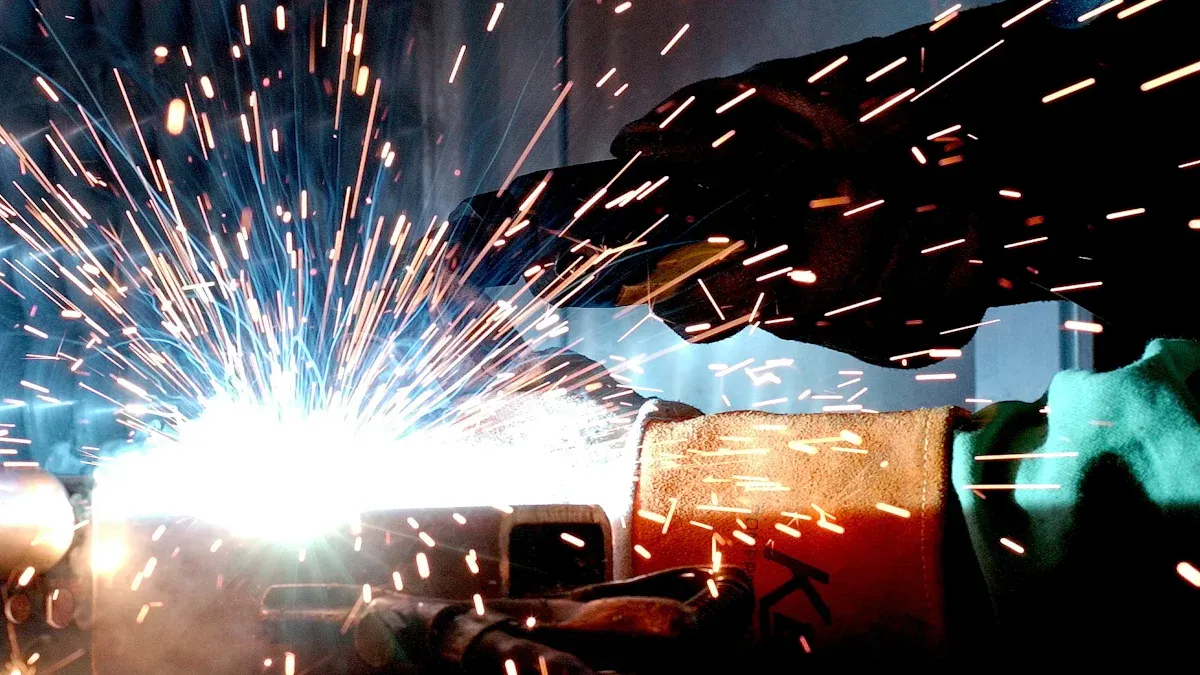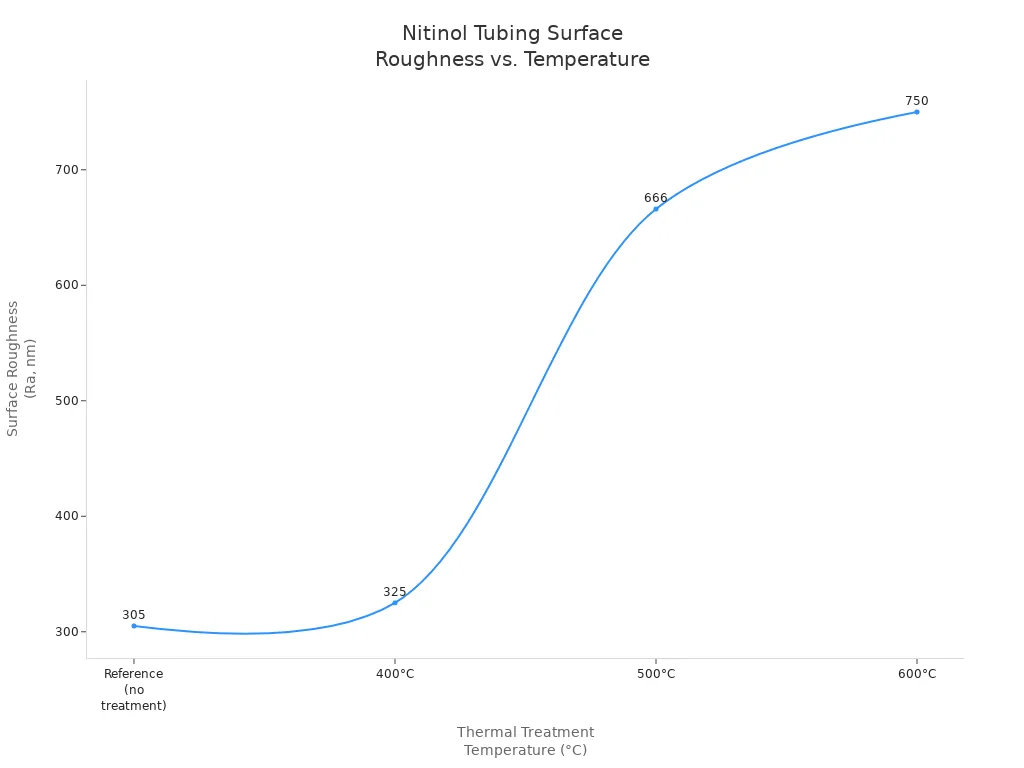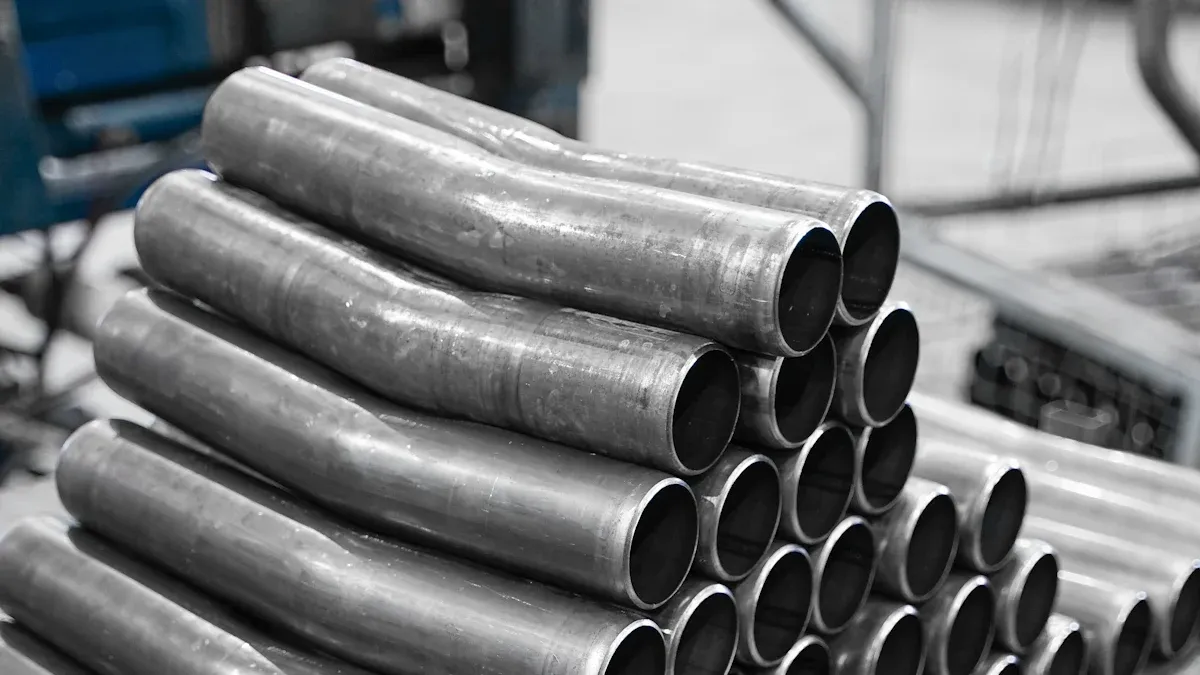How Manufacturing Steps Influence the Performance of Nitinol Tubing

The Nitinol Tubing manufacturing process plays a crucial role in determining the performance of the tubing. Careful control of the Nitinol Tubing manufacturing process impacts its durability and structural integrity, which in turn affects its reliability. Research shows that heating and shaping nitinol during the Nitinol Tubing manufacturing process alters its strength. These steps also change its internal structure, which is important for its longevity. Medical devices rely on these factors to function properly. Approximately 67% of nitinol tubing produced through the Nitinol Tubing manufacturing process is used in the medical field, while the remainder is utilized in industrial applications. Consistency in the Nitinol Tubing manufacturing process is essential for companies to ensure that nitinol performs optimally in demanding environments.
Key Takeaways
Every step in making nitinol tubing changes its strength, shape memory, and surface look. These changes affect how long it lasts and how well it works. - Keeping out bad materials and using careful heat helps nitinol tubing last longer. It also helps it work better in medical tools. - Surface finishing, like electropolishing, takes away flaws. It stops rust and lowers nickel release. This makes the tubing safer for people. - TM-1 processing makes tubing stronger and last longer. It uses special tools and cleaning steps, unlike TM-2. - Changing nitinol tubing’s size, heat, and alloy mix lets makers build devices for special medical needs. This helps patients get better results.
Nitinol Tubing Manufacturing Process

The nitinol tubing manufacturing process has many careful steps. Each step changes how the tubing works and looks. These steps affect the inside structure, strength, and smoothness of the tubing. The table below shows the main steps and the usual temperatures used:
Manufacturing Step | Description | Typical Temperature Range |
|---|---|---|
Melting and Alloying | Melting nickel and titanium using vacuum induction melting (VIM) and vacuum arc remelting (VAR) to control impurities and composition. | N/A |
Hot Working | Extrusion, forging, or rolling to refine grain structure and prepare for further tube processing. | 600–1050°C |
Cold Working and Drawing | Drawing tubing through dies to achieve precise dimensions and increase strength. | Room temperature |
Heat Treatment | Shape setting and annealing to set memory and superelasticity. | 400–500°C |
Surface Finishing | Polishing, electropolishing, and cleaning for smooth, biocompatible surfaces. | N/A |
Melting and Alloying
Making nitinol tubing starts with melting nickel and titanium. VIM and VAR help remove bad stuff and make the alloy even. It is very important to keep out impurities. Even a little oxygen or carbon can make nitinol weaker. This also makes it wear out faster. ASTM F2063 rules limit these things for medical nitinol tubing. The amount of nickel and titanium must be just right. Small changes can change how nitinol bends and snaps back.
Hot Working
Hot working changes melted nitinol into tube shapes. Extrusion and rolling at high heat make the grains smaller. This makes the tubing stronger and easier to bend. Making the grains smaller helps with later steps. To stop rust, billets are covered in mild steel.

Cold Working and Drawing
Cold working and drawing make the tube thinner and stronger. If not done right, the tube can get too hard and break. Lubricants and careful control help make the tube the right size. Sometimes, the size is controlled to within ±0.005 mm. Tubes can be drawn many times to get much smaller. After drawing, heat treatment makes the tube bendy again.
Heat Treatment
Heat treatment is a key step for nitinol tubing. Tubes are heated to 400–500°C to set their shape. Mandrels or fixtures hold the tube in place. The Af temperature must be controlled for the tubing to work right. Annealing helps take away stress and makes the tube last longer.
Surface Finishing
Surface finishing is the last step for the tubes. Electropolishing makes the surface very smooth. This helps stop rust and makes the tubing safe for the body. It also removes tiny flaws that could cause problems later.
Careful control at every step helps nitinol tubing meet tough quality rules for hard jobs.
Impact on Nitinol Properties

Microstructure
Nitinol tubing changes inside at every step. Melting and alloying decide grain size and phase mix. Some new methods, like Selective Laser Melting, make grains smaller. These methods also help balance the phases. Fast cooling makes nitinol harder and stronger. Keeping oxygen low is very important. Too much oxygen makes the tubing weaker and less bendy. Additive manufacturing, like micro laser metal wire deposition, makes the inside almost even. This gives high density and few cracks. The tubing keeps its shape memory alloy behavior. This helps it work well and last long. Sometimes, defects show up inside the tubing. These can be things like stress-induced martensite or dislocations. These problems change how the tubing handles stress over time. The way grains line up matters too. Grains in the (111) direction help stop fatigue. If the texture changes, weak spots can form. Careful control at each step keeps the inside strong and bendy for a long time.
Fatigue Life
Fatigue life is very important for nitinol tubing. This is true for medical devices. Every step, from drawing to heat treatment, changes how the tubing bends and stretches. Some tube methods, like TM-1, use special dies and mandrels. These close gaps and make the tubing stronger. TM-2 methods can add more defects. This makes the tubing not last as long. The size and spread of inclusions matter a lot. Smaller inclusions mean fewer places for cracks to start. This helps the tubing last longer. Tests show TM-1 tubing lasts two to three times longer than TM-2. High-purity alloys with strict controls work best.
Nitinol Alloy Grade | Testing Method | Approximate Fatigue Life / Strain Limit | Key Observations |
|---|---|---|---|
High-Purity VAR | Wire tension–tension | Fatigue strain limit ~0.32% at 10⁷ cycles | Highest fatigue resistance; fewer and smaller inclusions |
High-Purity VAR | Tubing bending (diamond) | Fatigue strain limit up to ~1.75% under bending | Superior fatigue life under bending fatigue testing |
Process-Optimized VIM+VAR | Tubing bending (diamond) | Fatigue strain limit ~1.5% | Slightly lower than High-Purity VAR; improved fatigue resistance |
Standard VAR, VIM, VIM+VAR | Both methods | Fatigue strain limit ~0.16% | Higher inclusion size and density; lower fatigue performance |
Fatigue tests, like ISO 25539-1 and ASTM F3211, check if tubing is safe for medical use. These tests copy real-life use. They show if tubing can last through many bends without breaking. Makers must watch every detail, like die material and how much they shrink the tube. This helps get the best fatigue life and keeps the tubing strong.
Good fatigue life needs steady steps and tight control of inclusions and microstructure.
Shape Memory and Superelasticity
Nitinol’s shape memory and superelasticity come from its nickel-titanium mix and heat treatment. Changing nickel by just 1% can change the temperature by 100°C. Makers must keep the mix within ±0.05%. This makes sure the tubing works at the right temperature. Heat treatment sets the Austenite Finish (Af) temperature. This tells when the tubing will change shape. Cold working and annealing also change how the tubing acts. After the right steps, superelastic nitinol tubing can stretch 4% to 5.2%. This means it bends and goes back to its shape, even after big bends. Makers can pick the right temperatures and stretch range for each job, like stents or guidewires.
Manufacturing Step | Influence on Transformation Temperature and Properties |
|---|---|
Ni-Ti Ratio | Critical; a 1% change can shift transformation temperature by ~100°C. Tight control (±0.05%) needed to keep temperature within ±5°C. |
Hot Working (600–900°C) | Enables large deformation; affects microstructure and transformation behavior. |
Cold Working | Shapes final product; influences phase transformations and mechanical properties. |
Annealing (600–800°C) | Full annealing after deformation impacts microstructure, phase transformation temperatures, and mechanical properties. |
Recrystallization Temp | Must be optimized; too low leaves residual stresses, too high causes grain growth affecting properties. |
Surface Treatments | Indirectly affect transformation by improving corrosion resistance and biocompatibility, important for medical-grade Nitinol. |
Shape memory and superelasticity need careful control of mix and heat during tube making.
Surface Quality
Surface quality is very important for nitinol tubing. It helps the tubing last long and stay safe in the body. Electropolishing and passivation take away flaws and add a safe layer. These steps make the tubing resist rust. The tubing can handle over 600 mV before breaking down. Smooth surfaces let out less nickel. This lowers allergy risk and helps the tubing last longer. Nickel release drops from about 6.0 µg/day to 0.2 µg/day in 35 days. This is much lower than FDA limits.
Common surface problems, like inclusions, microcracks, and dents, can start cracks. This lowers how well the tubing works. Rules say inclusions must be smaller than 39.0 μm. Special tests, like eddy current and ultrasonic, find these problems. Electropolishing and chemical etching smooth out cracks and clean the tubing. Clean rooms and strict rules keep the tubing safe for medical use.
Good surface quality helps nitinol tubing meet tough rules for safety, strength, and long life.
Processing Methods Compared
TM-1 vs TM-2
Nitinol tubing can be made in different ways. The two main ways are TM-1 and TM-2. TM-1 uses special diamond dies and hard mandrels. It also uses vacuum or inert anneals. TM-1 includes cleaning and electropolishing. This removes about 25% of the tubing’s weight. TM-1 makes tubing with smaller inclusions. It also helps heal the matrix inside the tube. These things make the tubing stronger. There are fewer weak spots inside. TM-1 tubing lasts two to three times longer than TM-2. TM-2 uses a different process. It makes bigger inclusions and less healing. TM-2 tubing is not as strong or long-lasting.
Aspect | TM-1 Processing | TM-2 Processing |
|---|---|---|
Manufacturing Technique | PCD dies, hard mandrels, vacuum/inert anneals, surface cleaning | Different technique, less specified |
Microstructure | Smaller inclusions, more matrix healing | Larger inclusions, less matrix healing |
Fatigue Life Performance | 2–3x higher fatigue endurance | Lower fatigue endurance |
Surface Treatment | Electropolishing removes defects | Less optimized surface treatment |
Summary | Superior quality and durability | Inferior microstructure and properties |
TM-1 makes tubing that is stronger and lasts longer. This is why it is picked for tough jobs.
Mechanical vs Thermal Effects
Mechanical and thermal steps both shape nitinol tubing. Mechanical steps like hot extrusion and cold drawing form the tube. They also make the grains smaller and stronger. These steps help the tube keep its shape. Annealing in the middle takes away stress. It makes the tube bendy again. Grinding and laser cutting make the surface smoother.
Thermal steps use heat to give nitinol its special powers. Heating at 400°C to 550°C sets the shape memory. It also changes the temperature when the tube changes shape. Heat treatment makes the tubing stronger. Both steps must work together. This makes tubing that is strong, bendy, and works well.
Surface Treatment Variations
Surface treatments help nitinol tubing last longer and stay safe. Electropolishing makes a smooth, nickel-free layer. This layer stops rust and keeps nickel from coming out. This makes the tubing safer for people. Chemical passivation adds another safe layer. Makers test the tubing with ASTM F2129 and other tests.
Electropolishing and passivation take away flaws and inclusions.
Smoother surfaces stop rust and cracks from starting.
Better surfaces help the tubing last longer and be safe in the body.
Good surface treatments help nitinol tubing meet strict rules and work well in people.
Practical Implications
Medical Device Reliability
Medical devices need nitinol tubing to work well and stay safe. Makers watch every step to help the tubing last longer. They check the grain structure and surface to stop early breaks. Stents and guidewires must handle many bends without snapping. Fatigue tests make sure the tubing stays strong under stress. Good nitinol tubing lowers the chance of problems during important surgeries. Hospitals trust devices that keep their strength and work the same over time.
Customization for Applications
Nitinol tubing can be changed for different uses. Makers change settings to fit what doctors need.
Shape memory and superelastic nitinol help make stents and guidewires that fit the body.
Laser cutting and new ways of making things let makers design tricky devices.
Custom tubing fits better, causes fewer problems, and feels better for patients.
Better fatigue life and safe materials help with long-term use in heart and small surgeries.
Engineers can change wire size, how stiff it is, and how it reacts to heat for each job.
Changing the nickel-titanium mix or adding niobium makes tubing last longer.
Special steps keep the tubing smooth and the right size, making it work better.
Changing tubing helps make new devices that help doctors work better and patients heal faster.
Quality and Regulatory Needs
Medical nitinol tubing must follow strict rules for quality and safety. ASTM F2063 lists what the tubing must be made of and how strong it should be. ASTM F2082 checks things like superelasticity, shape memory, and how well it fights rust. Makers test the tubing without breaking it and check its size and strength. They send reports to the FDA and keep ISO 13485:2016 for quality. These steps make sure nitinol tubing is safe, strong, and works well for patients everywhere.
The way nitinol tubing is made affects how strong, bendy, and safe it is. The main steps are:
High-purity nickel and titanium are used. Vacuum Arc Remelting helps take out bad stuff.
Hot working and seamless tube drawing make the grains better. These steps also help get the right size.
Cold working with annealing makes the tubing stronger. It also helps take away stress.
Heat treatment and surface finishing come last. Electropolishing makes the tubing smooth and stops rust.
Quality checks and following medical rules are very important.
Makers can make better tubing by:
Using new tools like laser-based additive manufacturing.
Working with doctors and rule experts to learn more.
Using digital tracking to check quality.
If makers keep out impurities and do each step the same way, they can make nitinol tubing that is great for both medical and industrial jobs.
FAQ
What makes nitinol tubing different from other metal tubes?
Nitinol tubing can do things most metals cannot. It has shape memory and superelasticity. This means it can bend and then go back to its old shape. Most other metals stay bent if you bend them. That is why doctors use nitinol in many medical devices.
How does surface finishing improve nitinol tubing?
Surface finishing takes away tiny flaws and makes the tubing smooth. This helps stop rust and keeps nickel from coming out. It also helps the tubing last longer inside the body. Electropolishing is often used for medical nitinol.
Why is impurity control important during manufacturing?
If nitinol has too much oxygen or carbon, it gets weak. These impurities can make the tubing break early or not bend well. Makers use vacuum melting to keep these bad things out. Pure nitinol works better and lasts longer in tough jobs.
Can manufacturers customize nitinol tubing for specific uses?
Yes, makers can change:
How thick or thin the tube is
The temperature for shape memory
How smooth the surface is
What metals are in the alloy
These changes help the tubing work for many kinds of devices.
See Also
Manufacturing Processes Behind Nitinol Tubing For Healthcare Use
Detailed Steps To Create Nitinol Microtubing For Neurovascular Use
How To Choose The Best Nitinol Tubing: A Complete Guide
Comprehensive Overview Of Nitinol Parts And Production Methods
Nitinol Tubing Transforming The Future Of Medical Device Technology

